I think most people are happy to celebrate their birthdays every year, it is the one day you can be extremely happy or extremely depressed, of course depending if you are the half full or half empty type of person and age is a burden to you.
But, let’s go on a quick trip 100 years back.
Now not many people get to celebrate a centenary birthday but organisations do have this good fortune especially state departments albeit that they do evolve and may morph over time by the addition of more functions or a shift of functions, a case being the Department of Mineral Resources and Energy or the Department of Public Works and Infrastructure. These Departments however, could be renamed in 20 or 50 or even a 100 years from now. The Revenue Service of course is one of the oldest state departments in the world. They have been collecting revenue since forever. You have all heard the saying that there are two things in this life you cannot escape, one being death and the other being taxes.
But, I digress ever so slightly. About a 100 years ago in 1924, we were well into the first industrial revolution in South Africa, kick-started by non other than the discovery of diamonds in about 1860 and approximately twenty years later the discovery of gold (circa 1880), and as they say, the rest is history.
At the time, South Africa was still under colonial rule so these discoveries lead to the influx of people from all over the world to work on the mines and in industry in general. South Africa needed to develop its infrastructure. It needed to establish a transport system to handle the minerals that were mined and needed to be processed. Machines that were involved had to be maintained and built if necessary or imported. Shipping was in place as shipping was one of the primary forms of transport in those days. The British were naturally well developed in this area having conquered quite a bit of the world back then using ships which travelled west to east and back. The railways needed to be developed fast between the key cities inland and the major cities at the coast. Air transport would eventually follow and was relatively new in 1924.
South Africa was a different world back then, having come out of two major wars known as the Anglo-Boer wars at the turn of the century and then moving on into a world war, known as “World War 1”. As if this was not bad enough, South Africa was also experiencing a severe drought as well as a locust plague coupled with a catastrophic period of unemployment. This was a recipe for the unemployed to continue with civil unrest which had already been going on for a number of years, reaching a peak in 1922 with a number of deaths.
In order to deal with these labour related issues, a component was working under the auspices of the Department of Mines and Works. The time had however arrived, given the simmering environment (on-going civil unrest) to establish a Department to deal directly with labour related matters.
This gave rise to a new Department being born — the “Department of Labour”. Between 25 July 1924 when the functions were formally handed over, and August 1924 when the Government Notice 1305 of 6 August 1924 was published in the Government Newspaper (Staatskoerant) 8 August 2024. The Department comprised of six (6) sections each with its own responsibilities.
Over the past 100 years, the Department would experience the “great Depression” from 1929 for several years further adding to its already dire situation on unemployment, and another World War (WW2) from 1939 – 1945. South Africa would become a Republic in 1961 and would eventually become a Democracy in 1994 with a new Constitution in 1996.
Over the 100 years, the Department would expand its services. The inclusion of all its population in its services became paramount post 1994. Over the years services to all citizens of the Republic were not inclusive and disparities were huge which gave rise to decades of civil strife.

Also, during the past 100 years, the Department has seen several name changes leading up to its current name — “Department of Employment and Labour”. In addition to this change, there have been a number of Acts and Regulations that have been published, ensuring that the legislation remains relative to the period in order to ensure that the legislation does not lag far behind in order to address the issue of ‘sound labour relations’ at the workplace. By being a member of the International Labour Organisation (ILO), the Department also ensures that its legislation and services are on par with the rest of the world.
The staffing component is a far cry today from what it was when it first started. The Department now services all nine Provinces at a Provincial and a Regional level (126 Labour Centres) with about 9000 staff members. It also has several state owned entities that provide services and includes amongst others, NEDLAC, CCMA, Productivity South Africa, etc.
Why not check out the Department’s Annual Report to familiarise yourself with its services and its performance? The document is a treasure trove of information.
Tibor Szana
Chief Inspector OHS (Ret.)

https://www.linkedin.com/in/tibor-szana-011b6225/

